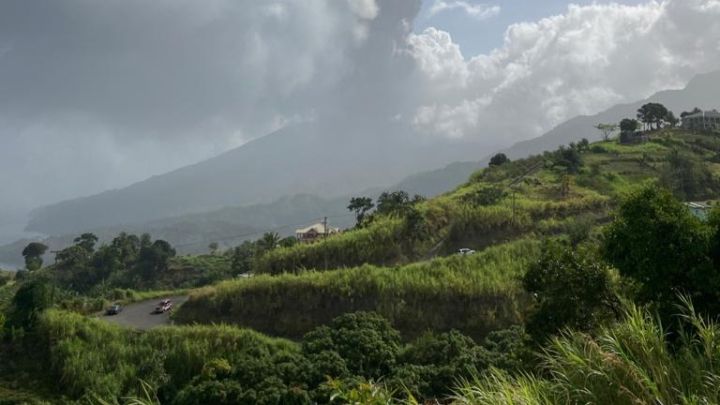The Caribbean island of St Vincent has been covered in a layer of ash after a volcano began erupting there on Friday. There is major disruption for islanders who are without power or water supply.
The eruption of the La Soufrière volcano has forced around 16,000 people to evacuate their homes. The Prime Minister Ralph Gonsalves has called for calm.
People living on the nearby island of Barbados have also been told to stay indoors as the ash spreads through the air. The volcano was dormant for decades but started to become active in December. Scientists warn that eruptions could continue for days - or even weeks.
The explosive volcanic eruption blanketed the island in ash and smoke and forced thousands of people out of their homes. La Soufrière, which has been dormant for decades, first started showing volcanic activity in December, but that increased.
The Prime Minister urged the residents in "red zones" to evacuate as the volcano has been spewing dark ash plumes 6 km (3.7 miles) into the air. Ash fall has been recorded as far from the volcano as Argyle International Airport some 20 km away, St Vincent's National Emergency Management Organisation (Nemo) said.
The volcano had been dormant since 1979, but in December it started spewing steam and smoke, and making rumbling noises. The first sign that an eruption was imminent came on Thursday evening, when a lava dome became visible on La Soufrière.
That same night, Mr Gonsalves ordered an urgent evacuation of the surrounding area.
Then on Friday, seismologists from the University of the West Indies confirmed that an explosive eruption was under way. Evacuees were taken to cruise ships and safer parts of the island.
One resident, Zen Punnett, said that he saw "a huge ball of smoke", and that there was panic when people were first ordered to evacuate. "I can feel and hear rumbling here in the green safe zone... keeping calm as much as possible and praying," he added.
Lavern King, a volunteer at shelters on the island, said: "People are still being evacuated from the red zone, it started yesterday evening and into last night. The place in general is in a frenzy." Inhabitants of the red zone constitute more than 10% of the country's population. Later on another explosion was recorded, the UWI Seismic Research Centre tweeted.
Some evacuation procedures were hindered by the heavy ash fall, which had made visibility "extremely poor", Nemo said.
"Now that the La Soufrière volcano has begun erupting explosively, ash falls will soon overwhelm us," the organisation wrote on Facebook, adding: "Be sure to get rid of or clean up the ash, soon after it falls. If rain falls, the ash could harden and pose a danger to you."
Most of the Lesser Antilles islands are part of a long volcanic arc in the Eastern Caribbean. The last eruption, in 1979, caused more than $100m (£73m) of damage on the island.
The worst eruption on record, in 1902, killed more than 1,000 people. Local media have also reported increased activity from Mount Pelee on the island of Martinique, north of St Vincent.
